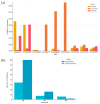Polymorphisms in CACNA1A, CACNA1C, and CACNA1H Genes in Korean Pediatric Patients with Developmental Delay and Intellectual Disability: A Focus on Epilepsy Comorbidity
- PMID: 40725423
- PMCID: PMC12294729
- DOI: 10.3390/genes16070767
Polymorphisms in CACNA1A, CACNA1C, and CACNA1H Genes in Korean Pediatric Patients with Developmental Delay and Intellectual Disability: A Focus on Epilepsy Comorbidity
Abstract
Background: Developmental delay and intellectual disability (DD/ID) are frequently accompanied by epilepsy, and growing evidence implicates variants in voltage-gated calcium channel genes in their pathogenesis. This study aimed to investigate the association of polymorphisms in CACNA1A, CACNA1C, and CACNA1H with DD/ID and epilepsy comorbidity in Korean children. Methods: We retrospectively analyzed 141 pediatric patients diagnosed with DD/ID who underwent whole-exome sequencing (WES) and were not found to have pathogenic monogenic variants. Nine single-nucleotide polymorphisms (SNPs) across CACNA1A, CACNA1C, and CACNA1H were selected based on functional annotation scores and prior literature. Genotype data were extracted from WES variant files, and allele and genotype frequencies were compared with control data from the gnomAD East Asian population and the Korean Reference Genome Database (KRGDB). Subgroup analyses were performed according to epilepsy comorbidity. Results: The CACNA1A rs16023 variant showed a significantly higher B allele frequency in DD/ID patients than in both control datasets and was also associated with epilepsy comorbidity. Genotype distribution analysis revealed that the BB genotype of rs16023 was more frequent in patients with epilepsy. Conclusions: The CACNA1A rs16023 variant may contribute to genetic susceptibility to DD/ID and epilepsy in Korean children, potentially through regulatory mechanisms. These findings support the relevance of calcium channel genes in neurodevelopmental disorders and highlight the importance of integrating functional annotation in variant prioritization.
Keywords: CACNA1A; CACNA1C; CACNA1H; developmental delay; epilepsy; intellectual disability; polymorphism.
Conflict of interest statement
The authors declare no conflicts of interest.
Figures

Similar articles
-
Calcium channelopathies and intellectual disability: a systematic review.Orphanet J Rare Dis. 2021 May 13;16(1):219. doi: 10.1186/s13023-021-01850-0. Orphanet J Rare Dis. 2021. PMID: 33985586 Free PMC article.
-
Genetic determinants of global developmental delay and intellectual disability in Ukrainian children.J Neurodev Disord. 2024 Mar 27;16(1):13. doi: 10.1186/s11689-024-09528-x. J Neurodev Disord. 2024. PMID: 38539105 Free PMC article.
-
Comprehensive phenotypes of patients with SYNGAP1-related disorder reveals high rates of epilepsy and autism.Epilepsia. 2024 May;65(5):1428-1438. doi: 10.1111/epi.17913. Epub 2024 Mar 12. Epilepsia. 2024. PMID: 38470175 Free PMC article.
-
Phenotypic Spectrum in Individuals With Pathogenic GABRG2 Loss- and Gain-of-Function Variants.Neurology. 2025 Jul 22;105(2):e213644. doi: 10.1212/WNL.0000000000213644. Epub 2025 Jun 26. Neurology. 2025. PMID: 40570274 Free PMC article.
-
A systematic review of neuropsychiatric comorbidities in patients with both epilepsy and intellectual disability.Epilepsy Behav. 2016 Jul;60:130-137. doi: 10.1016/j.yebeh.2016.04.018. Epub 2016 May 18. Epilepsy Behav. 2016. PMID: 27206231
References
MeSH terms
Substances
Grants and funding
LinkOut - more resources
Full Text Sources
Medical

